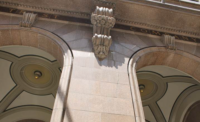
Engineers are using a newly developed carbon-fiber-reinforced geopolymer mortar as a conductor for cathodic protection (CP). The mortar helps to carry an electrical current through the steel frames of structures built before 1960, guarding against corrosion.
“We just take the joints out, put the necessary wiring in, re-tuck the joints with the anode material and refit the joint with heritage mortar. It’s as simple as that,” says Graeme Jones, managing director at C-Probe Systems Ltd., Altrincham, England.
Jones’ company, working with Mott MacDonald group, London, recently did its first commercial installation using the new geopolymer on the Commercial Trust Building in Kansas City, Mo. The 17-story, red granite and white terra-cotta tile building was completed in 1906. By the turn of the century, it showed signs of steel-frame corrosion and cracking in the main entrance’s granite, says Jones, noting that this is just one of thousands of similarly designed, similarly corroding structures around the world. These so-called heritage buildings, built with steel frames and masonry, were popular between the 1800s and 1950s and are vulnerable to corrosion, says Lambert. Commonly built in city centers, most were large structures, such as the town hall and bank offices.
To attack the problem, the C-Probe/Mott MacDonald team used mixed-metal-oxide-coated-titanium wire as a main anode to help conduct a small anti-corrosion electrical current, connecting it to the building’s steel frame. The firm’s new take on proven CP installation is to cover and connect the anode wires with carbon-fiber-laced geopolymer mortar, allowing for a less invasive primary anode installation and preserving the building’s appearance.
The geopolymer is artificial stone material that is more durable and less susceptible to thermal and chemically induced damage than portland cement, says Paul Lambert, Mott MacDonald head of materials and corrosion technology and a visiting professor at the Centre for Infrastructure Management at Sheffield Hallam University, Yorkshire, where he helped develop the geopolymer.
By adding carbon fibers to the geopolymer mix, the conductivity is amplified, shrinkage problems are reduced, and repairs last longer than those that use conventional mortar. The carbon fibers come from recycled sources, making the mortar environmentally friendly, as well, says Lambert.
A CP system protects steel members it reaches but doesn’t protect areas out of reach; however, it won’t make the steel worse or cause galvanic damage, he says. The alternative to installing a CP system is an invasive operation that involves stripping out the masonry, cutting out rusty steel and patching everything together again. This method solves the symptom, but not the cause, of corrosion, and it must be redone every 25 years or so, says Lambert. And that method is what has been used—in the 1940s, 1970s and 2000s, he notes.
“It’s almost entirely been a reactive and remedial operation,” he adds. “There are still people—in London, in particular—who think all you got to do is cut back that steel and get rid of the rusty bits. But you have to cut it back so much that it’s not going to be a steel frame anymore.”
Because this method is invasive and expensive, it is not ideal for the preservation of heritage structures, when maintaining the aesthetic is key, says Lambert. “It’s sort of like what plastic surgery does to Hollywood stars: It fixes them up, but they still don’t look quite genuine,” he says.
Aside from being discrete, a CP system saves up to 80% to 90%, compared to more invasive replacement work, says Jones. “The cost-effectiveness is enormous. It’s almost a no-brainer,” he says.




Post a comment to this article
Report Abusive Comment